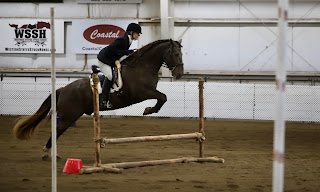In my experience it's been a rare Ease of Handling round that does not contain a 'jump'. I've also found in speaking with folks over the years that there is a LOT of nervousness around this obstacle because a LOT of folks just don't like to jump! It is definitely a skill to be practiced. I myself have a tendency to look down, and flap my elbows on the way over; as if doing so will help with lift off. Sigh, so much for style points.
If a person doesn't have a jumping background, it can be very unfamiliar and nerve wracking territory to complete this obstacle. I personally get even more intimidated if it's a solid object like hay bales vs. a pole.
I do find it helps me a lot to sit up, look up and even look WAY off ahead, instead of looking at the jump. I just try to pretend it isn't there..just another stride of trot or canter. I'd love to hear about techniques and/or advice in getting to the jump, executing it and recovering in time to prepare for the next obstacle, because I, for one, am not very good at it. Please chime in!
In terms of rules, the rule book says this: (bolding added by me)
Description. The obstacle consists of a single jump in a progression of heights for each level. Standard jump rails or a solid wood obstacle (like a flower box) can be used. Bales of straw placed end-to-end are acceptable. The jump must be at least 3-m (10-ft) across. The jump must be positioned between two jump standards with appropriate jump cups. L1: A single rail is placed on the ground between the jump standards; jump cups must be removed. Up to two ground rails may be set in front of the jump rail; each 1- to 1.2-m (3.5- to 4-ft) apart. L2 and L3: Jump consists of a pair of crossed rails not to exceed 0.5 m (22 in.) at the standard and 0.4 m (15 in.) at the center. L4 thru L7: Jump consists of a solid-looking obstacle or rails set 0.5-m (22-in.) high.
Execution. The horse should approach and jump over the obstacle cleanly, naturally, and with assurance. The obstacle may be required in both directions providing there is at least one obstacle in between the first and second execution.
Assessment Criteria (EOH). The Judge will evaluate the manner in which the horse approaches and leaves the obstacle; the horse’s calmness, straightness, and tempo throughout the obstacle; the bascule over the jump; and the pair’s confidence and style. Knocking over any part of the obstacle will result in a negative score.
Below are pictures of each level of jump. The last one is Adrienne Ray and her fabulous Clipper. I didn't ask permission so I hope you don't mind Adrienne (check out those tight and tidy front legs on Clipper!)
 |
| L1 (Intro) Jump (ground pole) |
There are lots of opportunities these days, all across the United States to join the fun of W.E. and practice your jumping skills! Find these events on the W.E Calendar here: W.E. Events and have a wonderful time JUMPING.




